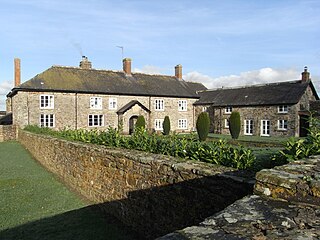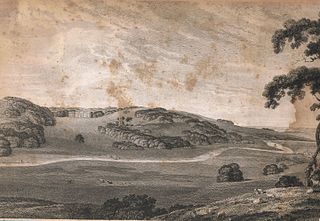Related Research Articles

Alveston is a village, civil parish and former royal manor in South Gloucestershire, England, inhabited in 2014 by about 3,000 people. The village lies 1 mile (1.6 km) south of Thornbury and 10 miles (16 km) north of Bristol. Alveston is twinned with Courville sur Eure, France. The civil parish also includes the villages of Rudgeway and Earthcott.
Fulk is an old European personal name, probably deriving from the Germanic folk. It is cognate with the French Foulques, the German Volk, the Italian Fulco and the Swedish Folke, along with other variants such as Fulke, Foulkes, Fulko, Folco, Folquet, and so on.

Fulk FitzWarin, variant spellings, the third, was a prominent representative of a marcher family associated especially with estates in Shropshire and at Alveston in Gloucestershire. In young life, early in the reign of King John (1199–1216), he won notoriety as the outlawed leader of a roving force striving to recover his familial right to Whittington Castle in Shropshire, which John had granted away to a Welsh claimant. Progressively rehabilitated, and enjoying his lordship, he endured further setbacks in 1215–1217.
Fouke le Fitz Waryn is a chivalric romance about the English baron Fulk III FitzWarin, written during the later 13th century, when the actual events of Fulk's life were still in living memory or common report. Probably originally composed in Old French verse, it survives only in an early 14th-century French prose version in a single manuscript in the Royal manuscripts, British Library, which is thought to follow the lost verse quite closely. The 16th-century antiquary John Leland saw and briefly described the French verse version, and made an extended abstract from a Middle English verse version called The Nobile Actes of the Guarines, the original of which is also lost. Various contemporary references show that the tale was widely-known in the later Middle Ages.

Almington is a small village in Staffordshire, England. It is about 2 miles (3.2 km) east-northeast of Market Drayton by road, to the northwest of the villages of Hales and west of Blore Heath. Historically the manor and Almington Hall belonged to the Pandulf family, and much later, the Broughton family.

Baron FitzWarin was a title in the Peerage of England created by writ of summons for Fulk V FitzWarin in 1295. His family had been magnates for nearly a century, at least since 1205 when his grandfather Fulk III FitzWarin obtained Whittington Castle near Oswestry, which was their main residence and the seat of a marcher lordship.
Maud 'Matilda' le Vavasour, Baroness Butler was an Anglo-Norman heiress and the wife of Fulk FitzWarin, a medieval landed gentleman who was forced to become an outlaw in the early 13th century, who is allegedly linked to the tale of Robin Hood and its origins.

James Audley, 2nd Baron Audley of Heighley Castle, Staffordshire, was an English peer. He was the son and heir of Nicholas Audley, 1st Baron Audley (1289–1316) by his wife Joan Martin, who was the daughter of William Martin, feudal baron of Barnstaple, and Marcher Lord of Kemes. She was posthumously the eventual sole heiress of her brother William FitzMartin to Barnstaple and Kemes.

Josce de Dinan was an Anglo-Norman nobleman who lived during and after the civil war between King Stephen of England and his cousin Matilda over the throne of England. He was a landholder in the Welsh Marches when he was married by Stephen to the widow of Pain fitzJohn, a union that gave Josce control of Ludlow Castle. Control of the castle was contested by other noblemen, and the resulting warfare between the nobles forms the background to a late medieval romance known as Fouke le Fitz Waryn, which is mainly concerned with the actions of Josce's grandson, but also includes some material on Josce's lifetime. Josce eventually lost control of Ludlow and was granted lands in compensation by Matilda and her son, King Henry II of England, who succeeded Stephen in 1154.

From AD 1066, the feudal barony of Barnstaple was a large feudal barony with its caput at the town of Barnstaple in north Devon, England. It was one of eight feudal baronies in Devonshire which existed in the Middle Ages. In 1236 it comprised 56 knight's fees or individual member manors. The feudal service owed for half the barony in 1274 was the provision to the royal army of two knights or four sergeants for forty days per annum, later commuted to scutage.

Brightley was historically the principal secondary estate within the parish and former manor of Chittlehampton in the county of Devon, England, situated about 2 1/4 miles south-west of the church and on a hillside above the River Taw. From the early 16th century to 1715 it was the seat of the Giffard family, whose mansion house occupied the moated site immediately to the west of the present large farmhouse known as Brightley Barton, a Grade II listed building which incorporates some elements of the earlier house. It is not to be confused with the 12th-century Brightley Priory near Okehampton.
Sybil was an Anglo-Norman noblewoman in 12th-century England. Her parentage is unclear, but her first marriage to Pain fitzJohn is well-attested. Through her marriage, Sybil transferred lands in several shires to her husband, including lands around Ludlow Castle and the castle itself. After Pain's death in 1137, Sybil attempted to retain control of Ludlow and her lands but in 1139 King Stephen of England married her to Josce de Dinan, who died in 1166. Sybil had two daughters with Pain and is probably the mother of Josce's two daughters also. Sybil's marriage to Josce, and his control of Ludlow in right of his wife forms the background to a medieval Welsh romance, Fouke le Fitz Waryn.
Manor of Siston is the ancient manor in Siston in South Gloucestershire, England.

The feudal barony of Bampton was one of eight feudal baronies in Devonshire which existed during the mediaeval era, and had its caput at Bampton Castle within the manor of Bampton.

The historic manor of Tawstock was situated in North Devon, in the hundred of Fremington, 2 miles south of Barnstaple, England. According to Pole the feudal baron of Barnstaple Henry de Tracy made Tawstock his seat, apparently having abandoned Barnstaple Castle as the chief residence of the barony. Many of the historic lords of the manor are commemorated by monuments in St Peter's Church, the parish church of Tawstock which in the opinion of Pevsner contains "the best collection in the county apart from those in the cathedral", and in the opinion of Hoskins "contains the finest collection of monuments in Devon and one of the most notable in England".
Margaret II Audley was a co-heiress to the feudal barony of Barnstaple in Devon, England.
William Pantulf was an Anglo-Norman nobleman and Baron of Wem. He was born in Hiémois, a county of Normandy, where his family had lived since around 1030. Pantulf held lands in Shropshire following the Norman Conquest of England. A vassal of Roger of Montgomery, the Earl of Shrewsbury, Pantulf was accused of murdering Roger's wife but proved his innocence of the charge by a trial by ordeal. When Roger's son Robert of Belleme rebelled against King Henry I of England, Pantulf did not take part and sided with the king. Upon his death, which most likely occurred in 1112, William's eldest son, Philip, inherited his Norman lands, and his second son, Robert, received the English lands.
Robert Pantulf was an Anglo-Norman nobleman.
Ivo Pantulf was an Anglo-Norman nobleman and feudal baron of Wem in Shropshire.

Fulk FitzWarin, 1st Baron FitzWarin, sometimes styled as Fulk V FitzWarin, was an English landowner and soldier who was created the first Baron FitzWarin in 1295, during the reign of King Edward I.
References
- ↑ Cokayne, The Complete Peerage , new edition, vol. V, p. 495, Baron FitzWarin
- 1 2 G.E. Cokayne, The Complete Peerage, V, p. 495, note (c)
- ↑ Suppe, F., 'Fitzwarine family (per. c. 1145-1315)', Oxford Dictionary of National Biography (2004), Vol. "F", pp. 953–4.
- ↑ The Complete Peerage , new edition, vol. V, p. 495, note (c)
- ↑ Janet Meisel, Barons of the Welsh Frontier: The Corbet, Pantulf, and Fitz Warin Families 1066–1272, (Lincoln: University of Nebraska Press, 1980), p. 34
- ↑ White 2004, p. 45.
- ↑ Janet Meisel, Barons of the Welsh Frontier: The Corbet, Pantulf, and Fitz Warin Families 1066–1272, (Lincoln: University of Nebraska Press, 1980), pp. 34, 35
- ↑ Pole, Sir William (d. 1635), Collections Towards a Description of the County of Devon, Sir John-William de la Pole (ed.), London, 1791, pp. 420–1